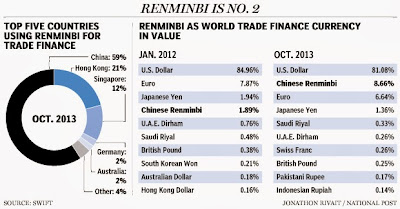In recent times, the Chinese yuan or renminbi has come on like gangbusters as more and more of these instruments are denominated in RMB. Reflecting China's emergence as the world's largest trading nation in merchandise, a significant minority of the world's letters of credit are now in RMB. In fact, it has now reached a milestone of overtaking the vaunted Euro in this application in the month of October of this year:
China’s yuan overtook the euro to become the second-most used currency in global trade finance after the dollar this year, according to the Society for Worldwide Interbank Financial Telecommunication [SWIFT]. The currency had an 8.66% share of letters of credit and collections in October [2013], compared with 6.64% for the euro, Swift said in a statement Tuesday. China, Hong Kong, Singapore, Germany and Australia were the top users of yuan in trade finance, according to the Belgium-based financial- messaging platform.So the dollar remains far and away the largest prominent currency in trade finance, but keep in mind where the yuan came from as late as January 2012 when it held less than a 2% share. Moreover, the appeal of the currency is coming on strong outside of China:
“It’s true that overseas exporters are using the renminbi more as the contract currency to increase the attractiveness and competitiveness of goods or services sold to China,” said Cynthia Wong, the Hong Kong-based head of emerging-market trading for Singapore and Hong Kong at Societe Generale SA.That said, the Chinese currency still has a long way to go in terms of becoming a vehicle currency for all sorts of payments and being widely exchanged one in forex markets:
The Chinese currency ranked No. 12 for transactions in the global payments system in October, unchanged from the previous month, according to Swift figures. Payment value for the currency rose 1.5% that month, less than the 4.6% growth for all currencies, the Swift data showed. That saw the yuan’s market share drop to 0.84% from 0.86% in September.So there's still a long way to go in terms of China allowing further capital account openness and market-trading for the yuan to become a legitimate rival to the dollar and the euro. Yet, the demand is likely there--especially for those who regularly trade with mainland China. That the currency is steadily appreciating is a further bonus to those who wish to hold it. To non-mainland residents, that is not an inconsequential draw:
Daily yuan transactions surged to $120 billion in April from $34 billion in 2010, making it the ninth most-traded currency in the world, according to a September report by the Bank for International Settlements in Basel, Switzerland.
The yuan has appreciated 2.3% against the greenback this year, the best performance in Asia, according to data compiled by Bloomberg...“I’m not surprised as cross-border trades between China and Hong Kong have been quite dominantly denominated in yuan,” Raymond Yeung, a Hong Kong-based senior economist at Australia & New Zealand Banking Group Ltd., said by phone today. “Yuan trades usually increase when there are strong expectations for yuan appreciation.”

Join This Site Show Konversi KodeHide Konversi Kode Show EmoticonHide Emoticon